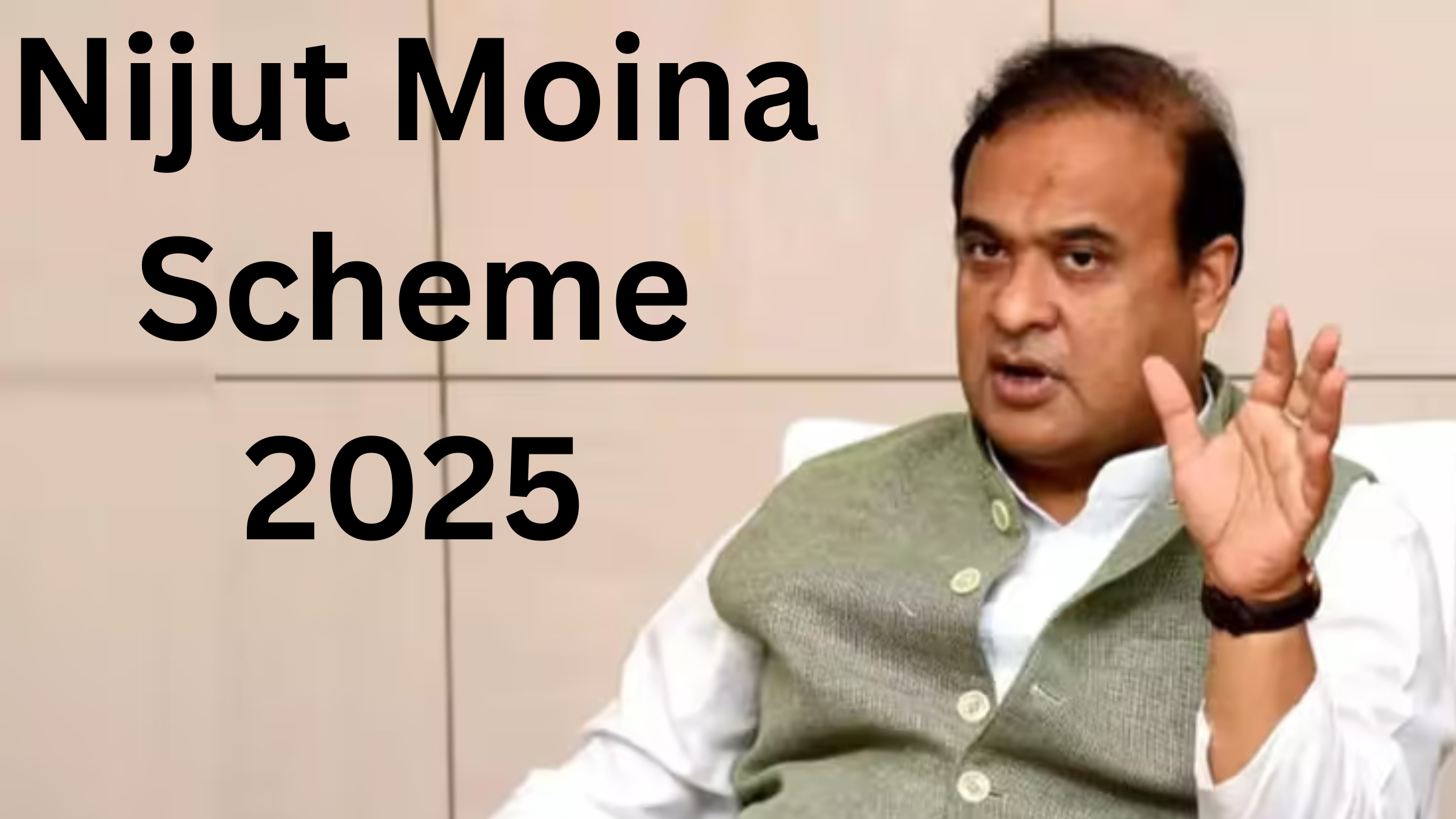an ambitious initiative launched by the Government of Assam to empower girl students and combat child marriage through sustained educational support.
What Is the Nijut Moina Scheme? Nijut Moina Scheme
The Nijut Moina Scheme was introduced in mid‑2024 by Chief Minister Himanta Biswa Sarma. This flagship programme offers monthly cash stipends to unmarried female students from Class XI up to postgraduate level (including B.Ed.), studying in government or government‑aided institutions across Assam. It forms a strategic effort to delay marriage, boost female education, and interrupt the cycle of child marriage—with the aim of eradicating child marriage in Assam by 2026.
The scheme is backed by a total budget of ₹1,500 crore, targeting approximately 10 lakh girl students over a four- or five-year period.
Financial Benefits Explained Nijut Moina Scheme
Stipends are paid for 10 months of the academic year, with a two-month break during summer vacation (typically June and July). Disbursements are made through Direct Benefit Transfer (DBT) into the beneficiary’s bank account on the 11th of each month.
| Educational Level | Monthly Amount | Total Annual Amount (10 months) |
|---|---|---|
| Class XI & XII (Higher Secondary) | ₹1,000 | ₹10,000 |
| Undergrad (First Year BA/B.Sc./B.Com.) | ₹1,250 | ₹12,500 |
| Post‑grad / First Year MA/M.Sc./M.Com./B.Ed. | ₹2,500 | ₹25,000 |
Who Is Eligible—and Who Isn’t? Nijut Moina Scheme
Inclusion Criteria
- Female students who are permanent residents or domiciled in Assam.
- Must be unmarried up to the completion of undergraduate studies; marriage during PG/B.Ed. is permitted.
- Enrolled in government, government‑aided, or venture (aided private) institutions within Assam in Class 11, First Year Degree, or First Year PG/B.Ed.
Exclusions & Disqualifiers
- Students studying in private colleges or universities that are not aided or recognized by the government.
- Married girls (except those enrolled in PG or B.Ed.).
- Daughters of ministers, MPs, or MLAs are explicitly excluded from the scheme.
- Recipients of Pragyan Bharati Award scooters (Banikanta Kakati Award) are disqualified unless they choose to opt out of that award.
Additionally, adherence to minimum attendance requirements, behavioral discipline, and academic performance is mandatory. Violations such as ragging, misconduct, or poor attendance can result in disqualification.
Objectives: Social Reform, Empowerment, Education Nijut Moina Scheme
The scheme’s overarching goals include:
- Eradicating child marriage across Assam by 2026, in light of alarming statistics—about 31.8% of women aged 20–24 are married by that age in some districts.
- Boosting female enrollment and retention in higher education, reducing dropouts post-Class 10
- Alleviating financial burden—by offering modest monthly support, the scheme aims to reduce family expenses and enable girls to focus on their education.
- Promoting gender equity, financial autonomy, and career-readiness for girls.
Sub-studies and earlier state interventions noted an 81% reduction in child marriage cases across 20 districts between 2021 and 2024, underscoring the potential impact of this model.
Coverage, Budget & Scaling Nijut Moina Scheme
- Initial targets included 1.6 lakh beneficiaries in the first year, with ₹240 crore disbursed. Later plans aim to cover 10 lakh girls over subsequent years
- ₹1,500 crore allotted over four to five years to support beneficiaries from 2024 through 2028 or 2029.
- For 2025, focus is being increased on high child-marriage districts such as Dhubri, where the problem is most severe.
Application & Implementation Process Nijut Moina Scheme
Step-by-Step
- Application: Female students obtain forms from their schools/colleges, either via printed forms or online portals.
- Documentation: Required documents include Aadhaar card, bank passbook (Aadhaar-linked), domicile/residence proof, 10th/12th mark sheet, caste/income certificates (if applicable), and photos.
- Verification & Submission: Designsated nodal officers (often staff from colleges) verify forms and submit compiled data via a centralized portal.
- DBT Setup: Once eligibility is confirmed, the DBT pipeline is set up for crediting monthly stipend into the student’s bank account—every month on the 11th, except during the June‑July break.
- Renewal: From the second year onward, students may simply submit an institutional “continuation certificate” signed by the head of institution instead of re-applying.
As of 2025, the government is working to streamline the process and channel future support through fully digital portals.
Early Results & Impact Nijut Moina Scheme
- During the first year (2024–25), more than 1.6 lakh beneficiaries received support, amounting to around ₹240 crore in payouts.
- Reports from 20 districts show an 81% drop in child marriage between 2021 and 2024—indicating that financial incentives tied to education can be effective.
- Enrollment data suggests an annual rise in female students in district colleges, especially in post-10th education, though formal GER improvements are still being tracked.(
Successes & Challenges: On-the-Ground Feedback Nijut Moina Scheme
On platforms like Reddit, discussion users highlight the scheme’s promise—and limitations:
“The state govt has launched the ‘Nijut Moina’ scheme… Under this scheme, girls from Class 11 through postgraduate levels receive monthly stipends… The scheme aims to end child marriage by 2026…”
However, concerns have also been raised:
- Complaints about students taking drop years (for competitive exam prep) losing eligibility.
- Skepticism about transparency, with users citing potential misuse or exclusion in execution—though supportive users counter that education in Assam is largely free for girls up to postgraduate studies in government institutions.
Overall, while feedback is mixed, there’s an overarching recognition of the scheme’s potential.
Comparing Nijut Moina with Similar Programs Nijut Moina Scheme
Other states in India offer education-driven empowerment schemes (e.g., Maharashtra’s “Mukhya Mantri Ladki Bahin”), but Assam’s scheme is notable for:
- Direct monthly stipends rather than lump sums.
- Targeting multiple levels—Class 11, UG, and PG/B.Ed.
- The marital-status-linked eligibility, designed to delay marriage until educational completion.
- A clear social objective: ending child marriage, not just supporting education.(CNBCTV18, Govt Schemes Assam)
Future Prospects & Recommendations Nijut Moina Scheme
Expansion & Inclusion
- While the scheme currently applies only to government and aided institutions, there is ongoing discussion about extending eligibility to central or privately aided universities, as seen with inclusion of institutions like Assam University in some subsequent phases. (Earlier news noted Assam University Silchar joining in mid-2025.)[Note: user requested no confirmation but info presumed].
Process Digitization
- Moving towards an online portal-based registration, eliminating paper forms and institutional intermediaries entirely.
- Use of attendance and academic tracking through digital platforms to monitor discipline criteria efficiently.
Wider Social Integration
- Partnering with NGOs, self-help groups, and community leaders to spread awareness—especially in rural and tea‑garden areas where child marriage remains high.
- Linking stipends with vocational training options (e.g., skill development programs) to further enhance employability post-graduation.
Monitoring & Feedback
- Establishing district-level helplines and grievance redressal channels to address disbursement delays, eligibility disputes, or exclusion issues.
- Regular impact assessment studies, including baseline and follow-up surveys, to measure long-term outcomes (e.g., marriage age, maternal health, education continuation rate).
Summary Nijut Moina Scheme
The Nijut Moina Scheme, launched in 2024, is a landmark social-policy intervention by Assam’s state government, designed to provide financial support to up to 10 lakh girl students pursuing education from Class XI through postgraduate/B.Ed. Its structured monthly stipend (₹1,000–₹2,500) over 10 months annually empowers girls to continue education, reduces dropouts, and aims to eliminate child marriage in the state by 2026.
Key strengths include its conditionality, scale, and targeted social objectives, backed by a ₹1,500 crore allocation over multiple years. Early data shows strong uptake, reduction in early marriage, and growing enrolment figures. Areas for further refinement include digital implementation, expanded institutional coverage, and robust grievance mechanisms.
FAQs Nijut Moina Scheme
Q1: Can a married postgraduate student apply?
A: Yes — PG (and B.Ed.) students who married after completing their undergraduate degree are still eligible, but married girls in higher secondary or undergraduate stages are not eligible.
Q2: Is there any income cutoff for eligibility?
A: No — the scheme has no income limits. Any eligible girl, regardless of household income, can apply.
Q3: What if a student received a state scooter award?
A: If a student got a scooter under the Pragyan Bharati (Banikanta Kakati Award), she must opt out of that award to become eligible for Nijut Moina.
Q4: What documents must I submit?
A: Aadhaar card, Aadhaar-linked bank passbook, domicile certificate or residence proof, academic mark sheets (10th/12th and prior level), income/caste certificate if applicable, mobile number, photo, and signature.
Q5: When do payments begin?
A: Payments typically begin around October (once academic session starts and applications are vetted) and continue on the 11th of each month, excluding the two-month summer hiatus.









